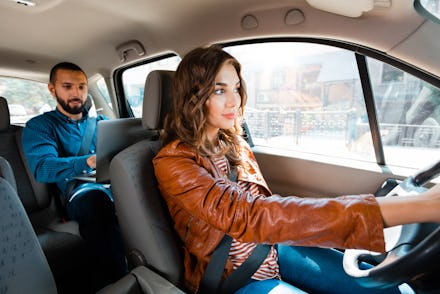This is exactly how your Uber rating is decided — and why it might be low

Every time you get out of an Uber, the app prompts you to rate your ride, granting the driver anywhere from one to five stars and evaluating them on criteria like vehicle cleanliness, conversation, and navigation. But in that process, it’s easy to forget that the driver is doing the same for you; and the result ties into your overall rider rating — you know, the one that’s displayed prominently under your name every time you open the app’s main menu.
Your rating is more than just a badge of honor: Drivers can see your number — which is anywhere from 1 to 5 stars — and reject your ride request if it’s too low. (Of course, “too low” is subjective, so it’s up to each individual driver to make the call as to what they’re comfortable with.) So, if you want to keep your ride options as open as possible (or just want bragging rights with your friends), there’s certainly incentive to being a consistently good passenger.
But how does your stellar ridership actually translate into a stellar score? “Rider and driver overall ratings are an average, and influenced by the number of trips taken, as well as ratings provided for each of those trips,” said Dhruv Tyagi, a product manager on the Driver Team at Uber. The number you see on your profile is an average of the past 500 ratings drivers have given you, or fewer, if you haven’t yet taken 500 rides.
Once you reach 500, a single low rating may not have a massive impact. Even so, it’s worth knowing what can elevate or tank your number. Tyagi said drivers typically consider three main areas in their ratings: wait times (“be ready to go when they arrive at the pickup location [and] be sure the location you entered is exactly where you’ll be”), courtesy (“treat drivers and their cars with care and respect”) and safety (“drivers want to make sure everyone in their car is safe, and shouldn’t feel pressured to break in laws, [such as speeding]”).
Ultimately, you don’t have to be an aggressively obnoxious rider to get a low rating. If you tend to talk loudly on your phone, flirt with your driver or comment on their appearance, or slam the door when you leave — all of which are against Uber’s community guidelines — that could be enough to lose yourself a star or two.
There’s no way to know which of your specific actions or behaviors brought down your average — “individual ratings are completely anonymous, and neither riders nor drivers see ratings tied to a particular trip or person,” Tyagi noted — if you find yourself with a number you’re not proud of, you can basically do the opposite of all of that and gradually work your way up to a flashy 4 or 5. As Tyagi said, “if a rider continues to be respectful and helps Uber be an enjoyable and safe experience for everyone, there should be a positive impact for ratings.”